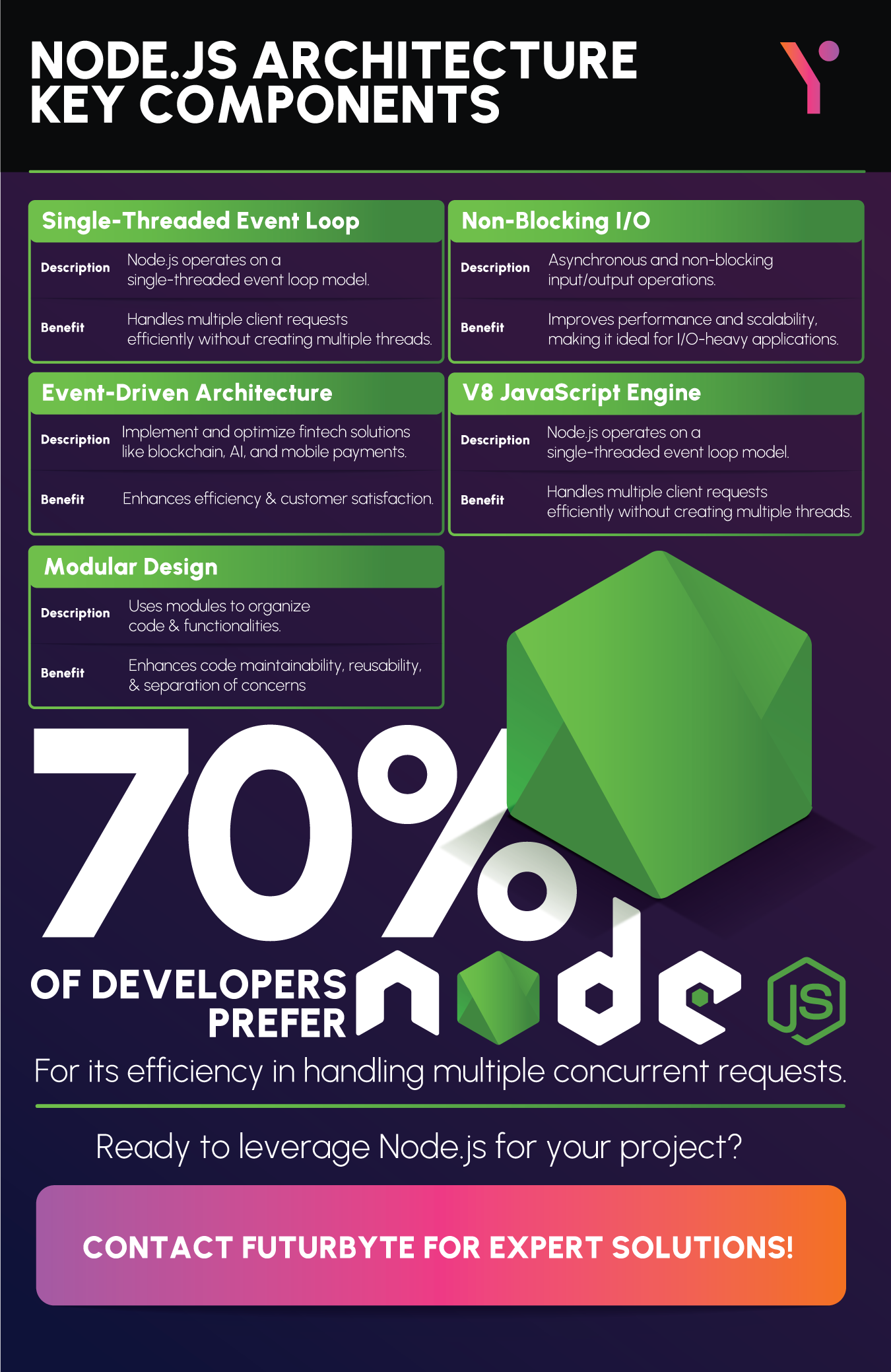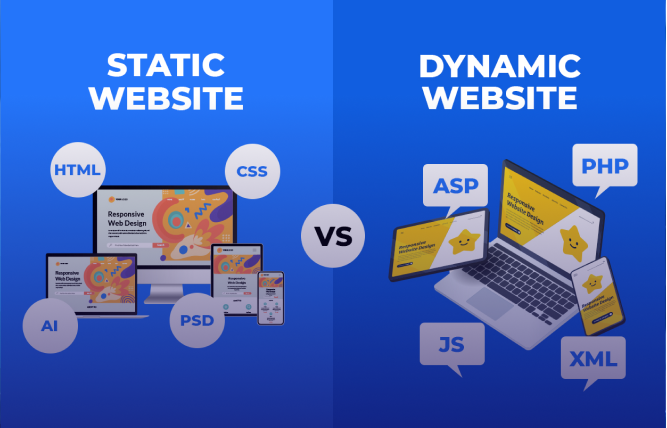Introduction
In this post, we’ll explore Node.js architecture in detail. We’ll start with the key principles, components, and the best way to adopt Node.js architecture for application development. We will also share our approach to adopting Node.js application architecture. Let’s get started!
Do you wonder why some applications are lightning-fast in terms of responsiveness and task execution while others are slow and sluggish? The secret often lies in the application architecture.
When we talk about building efficient and scalable applications, Node.js stands out as a top choice for developers. In this blog, we will see how Node.js architecture is the best for your next application and why it’s a game-changer for technology solutions for business.

The Importance of Architecture in Node.js
Node.js is a community-favored JavaScript runtime environment that simplifies the development process and allows you to build fast, scalable applications capable of handling millions of requests simultaneously. It’s no wonder that big names like Netflix, Uber, and LinkedIn trust Node.js for their backend needs.
Node.js uses Google Chrome’s V8 JavaScript engine, making it quick and efficient. Its event-driven, non-blocking I/O model suits high I/O demands and is ideal for single-page apps, video streaming, and online chat applications. Node.js is your best bet if you want lightweight and powerful applications.
Why Choose Node.js?
The benefits of using Node.js are numerous. Here’s a quick look at why it’s favoured by top companies:
- js processes tasks quickly, thanks to the V8 engine. This tackles a high volume of requests without slowing down.
- Whether you’re looking for an ecommerce development solution or cross-platform mobile app development, Node.js architecture can effortlessly scale your application.
- js’s non-blocking I/O model ensures that operations are executed efficiently, providing better performance and lower resource consumption.
Real-World Success with Node.js
Let’s take Netflix as an example.
Ever since they adopted Node js architecture, they witnessed a 70% reduction in startup loading time. The transition from front-end to back-end became smoother, reducing latency significantly. This made scaling much simpler, and the credit goes to Node.js’s asynchronous and non-blocking nature.
Another great example is LinkedIn.
They moved to Node.js for better performance on mobile devices. The result? Seamless user experience and blazing-fast response rate.
These success stories highlight how Node.js can revolutionise your application’s performance and scalability. But do not forget the need for detailed Node JS architecture. Don’t fret! If you are not technically strong, connect with our Node js experts to get full-scale Node js development services from FuturByte.
Key Principles of Node JS Architecture
Node.js is designed to be fast, scalable, and efficient. This makes it an ideal choice for technology solutions for business. At the heart of Node.js are some core principles that guide its architecture. Let’s break them down.
Event-Driven Architecture
Node.js uses an event-driven model, meaning it operates based on events and triggers. This is different from the traditional request-response model. When an event happens, like a user clicking a button, Node.js springs into action. This model makes it highly efficient and able to handle multiple tasks simultaneously without bogging down the system.
Non-Blocking I/O
Node.js is excellent for managing I/O operations. Non-blocking I/O is also popular in Node js; this allows the application to process multiple requests without having to wait for the operation to be completed. This is especially helpful if your project requires the use of WooCommerce or if you need to outsource any other custom development. It guarantees that the application appears as fast as you need it, even if it is heavily used.
Single-Threaded with Asynchronous Processing
Node.js is single-threaded but it is capable of performing several tasks at once because it follows the asynchronous approach. Unlike other programming languages where you have to wait for the execution of the first operation before starting the second one, Node js takes on the second operation simultaneously. This makes it fitting for large-scale business operations that require reliable node js development services.
Under the Hood: Key Components of Node.js Architecture
Node.js architecture revolves around its core components: a single-threaded event loop for efficient request handling, asynchronous operations with callbacks for responsiveness, modular design for scalability, and a vast package ecosystem for rapid development. These elements collectively enable robust, high-performance applications.
Single-Threaded Event Loop
The event loop in Node.js is a single thread that efficiently monitors incoming requests. Unlike traditional servers that handle requests sequentially, the event loop processes them concurrently for better performance.
Asynchronous Operations and Callbacks
Asynchronous operations in Node.js allow the event loop to handle other tasks while waiting for external resources. This is done using callbacks, which are executed once the task is complete, ensuring continuous responsiveness.
Modular Design
Node.js follows a modular design philosophy, breaking down code into smaller, reusable modules. This approach simplifies code maintenance and scalability, making it easy to add new features by integrating new modules.
Package Ecosystem
Node.js has a vast package ecosystem with pre-built modules for various functionalities, from database interactions to user authentication. This allows developers to accelerate development and focus on creating unique application features.
The Flow of Efficiency: Node.js Application Architecture
Now that we have a grasp of the basic elements, let’s examine how they interact with each other. Here is a basic overview of the workflow:
User Request: A user interacts with your application, sending a request to the server.
Event Loop in Action: The event loop receives the request and checks its nature.
Non-Blocking Operations: If the request doesn’t require external resources, the event loop processes it directly and sends a response back to the user.
Asynchronous Dance: If the request needs external resources, the event loop triggers a callback function. This function handles the task asynchronously, freeing the event loop to move on.
Callback Completion: Once the task is finished (e.g., database query complete), the callback function is executed, processing the results and sending the response.
This asynchronous choreography ensures your application remains responsive and zippy, even under heavy loads.
You need to understand these core components and workflow to gain a solid foundation for building efficient and scalable applications with Node.js. Whether you’re developing a custom e-commerce solution using WooCommerce or building a cross-platform mobile app, you need a well-defined application development architecture.
Ready to leverage the power of Node JS architecture? Consider FuturByte is a highly ranked company that offers Node.js development services. Our professionals can lead you through the complexity of microservices design and development, guaranteeing that your application remains flexible and scalable as your business requirements change.
Best Way to Adopt Node JS Architecture for Application Development
Implementing Node.js architecture in your application development can significantly transform the game in the best way. Here’s how to begin and utilise its features to the fullest.
Understand the Core Principles
Before you begin, make sure you understand the fundamental concepts of Node.js, like event-driven structure and non-blocking input/output. These are the factors that contribute to Node.js’s strength. Understanding the way, they operate will help you optimise your Node js architecture.
Start with a Strong Foundation
Begin with a solid project structure. Organise your code into modules to keep it clean and manageable. Modular approach not only makes your codebase simpler, easier, and readable to maintain but also facilitates collaboration among team members. This is vital when you work on large projects like custom WooCommerce development or cross-platform mobile app development.
Leverage Middleware
Employ middleware for activities like authentication, logging of activities, and even error checking. Middleware functions sit in the middle – rather like a pipeline – through which requests flow, and these can be useful when you have tasks that are peripheral to your main code but that you need to happen as part of the request-processing life cycle. This is more useful, especially in the cases of microservices design and development, where each service may have the ability to have its own middleware.
Optimise Performance
Performance optimisation is key in Node.js. You achieve this through the implementation of caching tactics that store commonly accessed data and reduce the load on your database. Optimise your database queries to minimise response times. These steps are essential for creating efficient and scalable ecommerce development solutions.
Monitor and Scale
One of the essential aspects of application maintenance is monitoring since it helps in identifying problems and addressing them promptly. You should regularly monitor your application using tools such as PM2 or New Relic in order to identify problems. When it’s time to scale, Node.js’s architecture makes it easy to distribute the load across multiple servers, ensuring your application can handle increased traffic smoothly.
That’s How FuturByte Leverages Node JS Architecture
At FuturByte, we use Node.js to build efficient, scalable applications. Here’s how we do it:
Embracing Event-Driven Architecture
We adopt Node.js’s event-driven architecture to create real-time applications. This approach lets us build responsive, interactive interfaces that handle multiple connections seamlessly, which is ideal for our real-time data analytics platform.
Utilising Non-Blocking I/O
We fully utilise Node.js’s non-blocking I/O to handle large data volumes. This ensures high performance and reliability in processing and analysing big data streams.
Implementing Microservices
We embrace microservices design to enhance scalability. We achieve greater flexibility and easier maintenance by breaking down applications into independent services. Node.js enables seamless communication between these services.
Focusing on Performance Optimisation
Our focus remains on implementing strategic caching mechanisms and optimise database interactions to deliver lightning-fast and dependable services, be it for e-commerce development solutions or other mission-critical applications.
Continuous Monitoring and Scaling
Our proactive approach involves continuous application performance monitoring (APM) with advanced tools, enabling us to address potential bottlenecks preemptively. Node.js’s horizontal scalability empowers us to effortlessly distribute workloads and maintain optimal performance under peak loads.
Wrapping Up
So, there you have it! Node.js architecture might sound like technical jargon; it’s a game-changer for building applications that can scale up and be efficient at the same time. All you need is to embrace the core principles of event-driven architecture, asynchronous operations, modular design, and a rich package ecosystem.
- Scalable Applications: Node js is best suited to handle massive user traffic with ease, allowing your application to grow seamlessly alongside your business.
- Efficient Applications: You get to maximise resource utilisation and minimise response times, delivering a smooth and responsive user experience.
- Maintainable Applications: Node Js lets you break down complexity into manageable modules, making your code easier to understand, update, and modify.
The upcoming trend in web development involves faster, scalable, and adaptable applications. Node.js architecture allows you to accomplish exactly that. Let’s utilise Node Js architecture’s strength to create tech solutions that drive your business to greater success!
Ready to take the next step? Get Node.js development services and build your future-ready application with FuturByte. Our experts help you navigate challenges that you might face with Node.js architecture and ensure your application is built for success.
Frequently Asked Questions
The event loop in Node.js manages asynchronous operations by continuously checking for tasks, executing them, and handling callbacks efficiently on a single thread.
Security considerations for Node.js architecture include input validation, secure authentication methods, HTTPS encryption, secure handling of environment variables, and regular updates to mitigate vulnerabilities.
Businesses benefit from specialised Node.js development companies by gaining access to expertise, faster development cycles, customised solutions tailored to their needs (like custom WooCommerce development or cross-platform mobile app development), ongoing support, and innovation with the latest technologies.
Yes, Node.js is well-suited for microservices architecture due to its lightweight nature, scalability, and ability to handle multiple concurrent requests efficiently.
Common design patterns in Node.js include Module, Singleton, Factory, Observer, and Middleware patterns, which help organise and manage code effectively.
Node.js implements efficient caching strategies using in-memory caching, external solutions like Redis or Memcached, Cache-Control headers for HTTP responses, and managing cache expiration to optimise data retrieval.
Node.js architecture optimisation for serverless computing involves breaking down applications into smaller functions, minimising dependencies to reduce cold start times, designing stateless applications, and leveraging auto-scaling capabilities based on demand.
The cost of developing Node.js architecture depends on:Project Complexity: More complex projects are more expensive.Features and Functionality: Advanced features and customisations increase costs.Team Expertise: Hiring experienced Node.js experts or a specialised development company may cost more.Location: Development costs vary by region; offshore teams may be cheaper.Timeline: Shorter timelines may require more resources, raising costs.Overall, Node.js architecture development costs are subjective, depending on your requirements.
Have questions or feedback?
Get in touch with us and we‘l get back to you and help as soon as we can!




